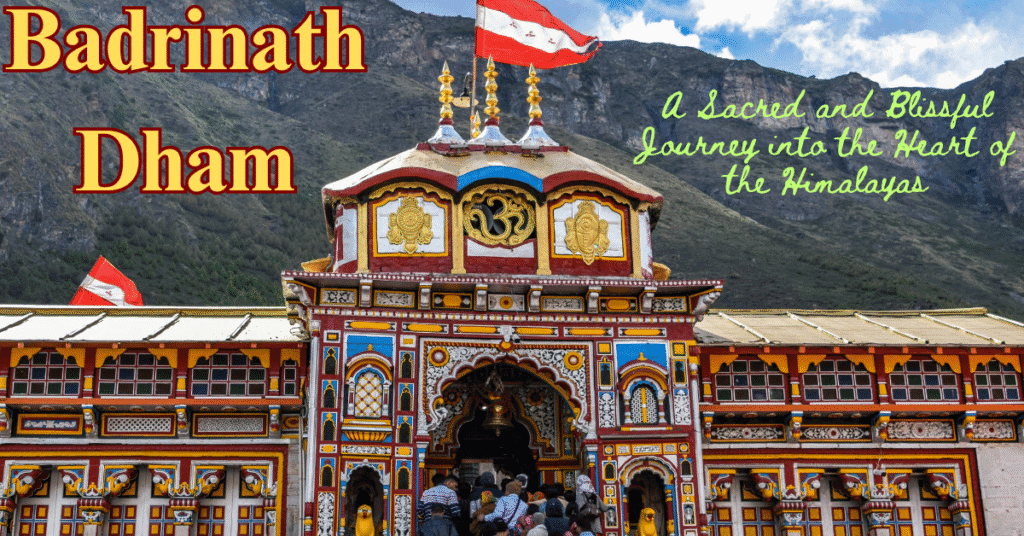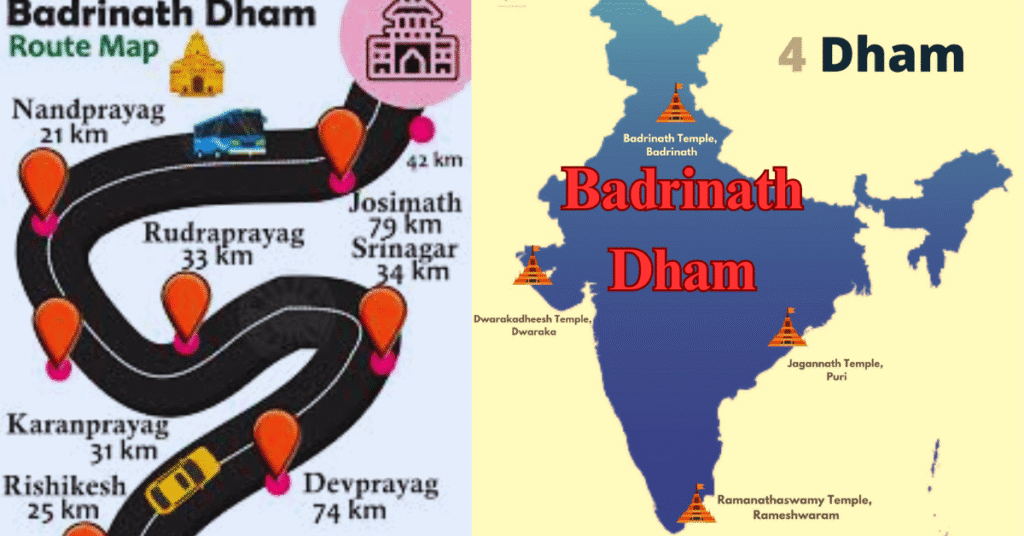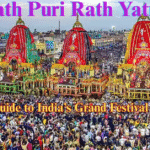
Table of Contents
Badrinath Dham
Badrinath Dham
Badrinath Dham, nestled in the tranquil heights of Uttarakhand’s Garhwal Himalayas, is one of the most revered spiritual destinations in India. Part of the prestigious Char Dham Yatra—which includes Rameshwaram, Dwarka, and Jagannath Puri—Badrinath holds a special place in the hearts of millions of Hindu devotees. Dedicated to Lord Vishnu, this sacred site is not only a pilgrimage but a journey into spiritual elevation, natural beauty, and divine legends.
Badrinath Dham: Gateway to Northern Salvation
Situated in the Chamoli district of Uttarakhand, Badrinath is also part of the smaller yet equally significant Chota Char Dham circuit. Perched at an elevation of 3,133 meters on the banks of the Alaknanda River, the temple of Badrinarayan is surrounded by the mighty Nar and Narayan mountains, echoing the legends that give the Dham its divine aura.
Mythology and History: Where Legends Come Alive
The origins of Badrinath are steeped in rich mythological and historical significance:
- It is believed that Lord Vishnu, during the Satyuga, meditated here as Nara and Narayana. When mocked by Narad Muni for resting, Vishnu chose this site for deep penance. Goddess Lakshmi protected him in the form of a Badri tree, lending the temple its name.
- The temple gained prominence when Adi Shankaracharya discovered the idol of Lord Vishnu in the Alaknanda River and installed it near Tapt Kund, a natural hot spring. The idol was later moved to a grand temple by the 16th-century King of Garhwal.
- In the Kaliyuga, it is said Lord Vishnu vowed not to appear in physical form, making a visit to Badrinath equivalent to receiving his divine darshan.
Spiritual Significance of Badrinath
Thousands of pilgrims visit Badrinath Dham not only to seek blessings but also to perform Pind Daan (ancestral rites) at Brahma Kapal for the moksha (liberation) of departed souls. It is widely believed that visiting Badrinath purifies the soul and helps one transcend material bondage.
How to Reach Badrinath Dham
✈️ By Air:
- Nearest Airport: Jolly Grant Airport (Dehradun)
- Taxis are readily available from the airport to Govindghat or directly to Badrinath.
- Alternatively, fly to Delhi and travel by road or train.
🚆 By Rail:
- Nearest Railway Stations: Haridwar and Rishikesh
- Buses and taxis from these stations take pilgrims via Govindghat to Badrinath.
🚌 By Road:
From Delhi, buses depart from Kashmiri Gate ISBT to Haridwar. The road journey continues through:
- Rishikesh
- Devprayag – Confluence of Alaknanda and Bhagirathi
- Rudraprayag – Alaknanda and Mandakini rivers meet
- Karnaprayag – Meeting point of Alaknanda and Pindar
- Nandprayag
- Joshimath
- Govindghat
- Pandukeshwar
- Hanuman Chatti – Last stop before Badrinath
This enchanting route also includes the five sacred river confluences, collectively called Panch Prayag.

Top Places to Stay in Badrinath
As the town is accessible by vehicle, pilgrims can find several comfortable accommodations:
- Bhajan Ashram Badrinath
- Om Kutir
- Hotel Charan Paduka
- New Hotel Snow Crest
- Hotel New Yoga
Must-Visit Attractions Near Badrinath Dham
Apart from the temple, Badrinath is surrounded by spiritually and naturally rich sites:
- Auli – A popular ski resort offering stunning views and adventures.
- Valley of Flowers – A UNESCO World Heritage Site that blooms vibrantly in July.
- Hemkund Sahib – A sacred Sikh pilgrimage site reached by trekking from Govindghat.
- Charan Paduka – A sacred rock imprinted with Lord Vishnu’s footprints.
- Vasudhara Falls – A 400-foot majestic waterfall located 9 km away.
- Tapt Kund – A natural hot water spring for ritual bathing.
- Bhima Pul – A legendary stone bridge built by Bhima over the Saraswati River.
- Narada Kund – The divine spot where Adi Shankaracharya found the deity of Badrinath.
- Vyasa Gufa – The ancient cave where Sage Vyasa composed the Mahabharata.
- Brahma Kapal – Important for offering prayers to ancestors.
- Yoga Dhyan Badri Temple – One of the seven sacred Badri temples.
- Mata Murti Temple – Dedicated to the divine mother of Nara-Narayana.
- Mana Village – India’s last inhabited village before the Indo-Tibet border.
- Pandukeshwar – Believed to be the meditation site of King Pandu.
- Satopanth Lake – A stunning glacial lake surrounded by serene peaks.
BadrinathDham #CharDhamYatra #SpiritualIndia #UttarakhandTourism #HimalayanPilgrimage #LordVishnu #IncredibleIndia #TempleTourism #PanchPrayag #AdiShankaracharya
Conclusion: A Journey of Faith and Inner Peace
Badrinath Dham is not just a destination—it’s a divine experience that combines spirituality, mythology, and the breathtaking beauty of the Himalayas. Every step taken on this sacred path brings one closer to inner peace and spiritual awakening. Whether you’re a devout pilgrim or a curious traveler, Badrinath welcomes you with open arms and a heart full of blessings.


